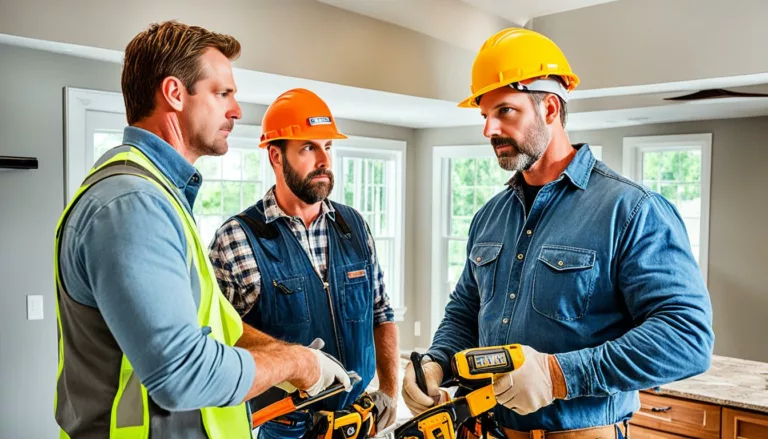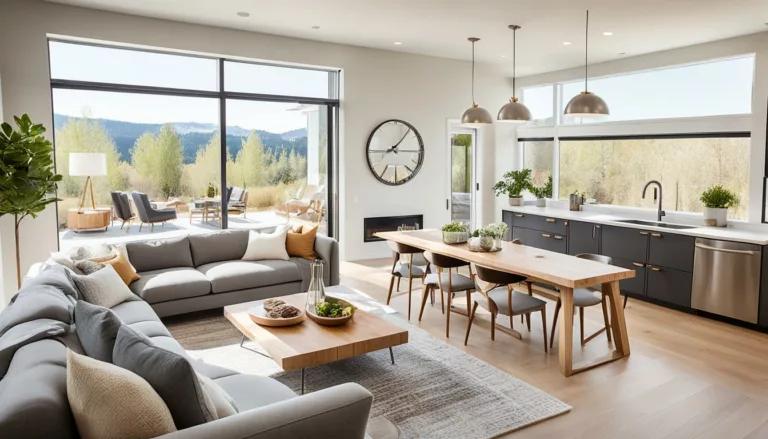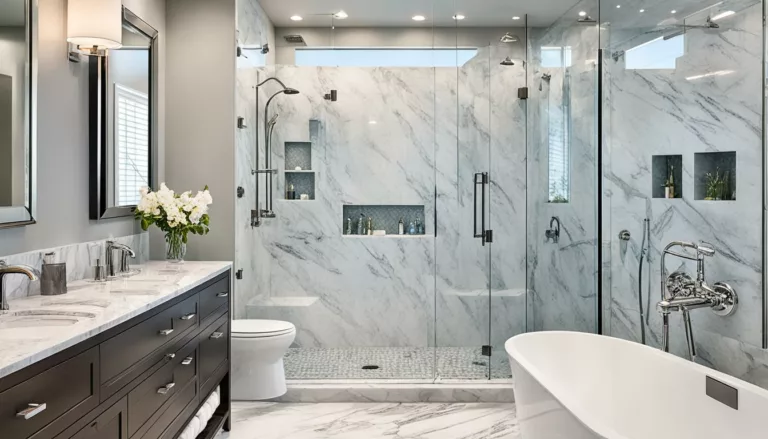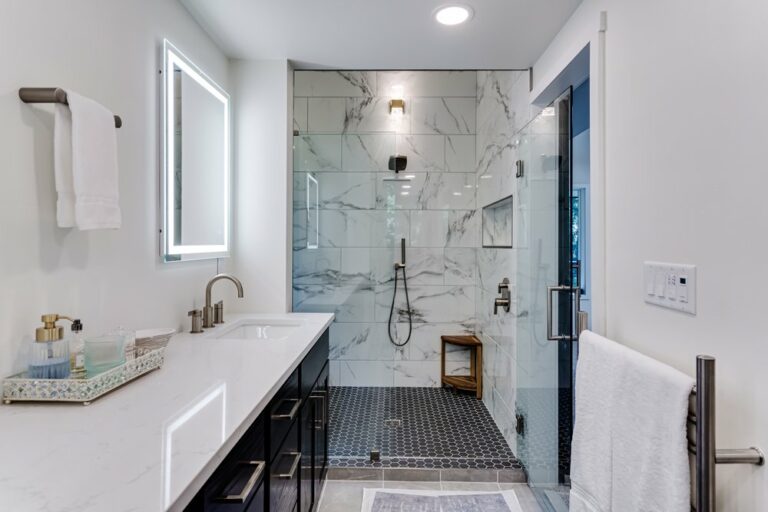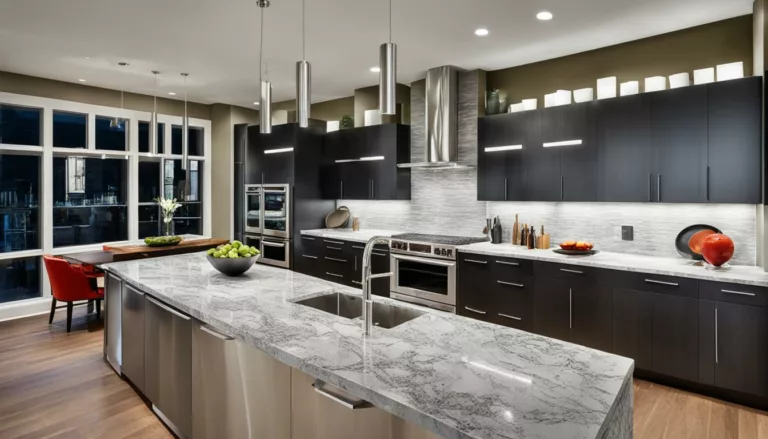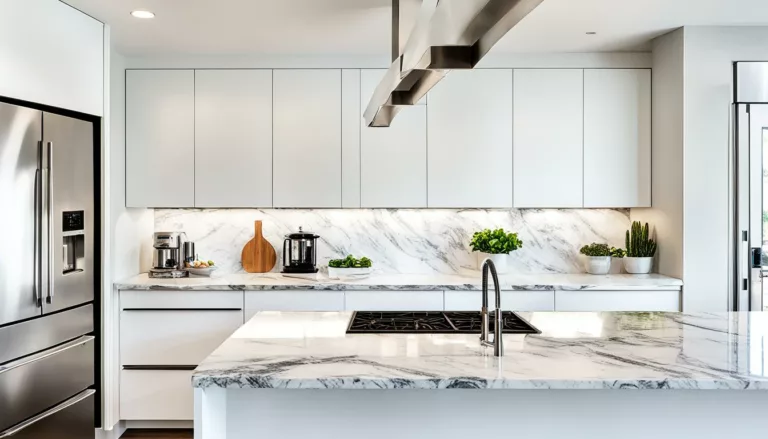Do you want your home or office to show off your style and lift your spirits every day? The design world is always changing, making it hard to keep up with trends. But don’t worry, this article will guide you through the exciting world of design. It will help you make a space that looks great and fits your taste.
Picture entering a room where everything works together perfectly. The colors and typography tell your story, showing off your style and values. Whether you love simple designs or bright colors, we’ll show you how to make your space reflect your unique taste.
Key Takeaways
- Discover the latest design trends that are captivating spaces across the United States
- Explore innovative concepts, from minimalist aesthetics to bold color palettes
- Learn how to incorporate cutting-edge design elements, such as typography, user experience, and sustainable practices
- Create a space that aligns with your personal style and stays ahead of the design curve
- Enhance the overall look and feel of your home or office with the hottest design trends
Minimalism: Less Is More
Minimalism is a trend that focuses on simplicity and functionality. It makes your space calm and clear. This lets the important things stand out.
Embrace Simplicity and Functionality
Minimalist design is all about simplicity and functionality. Don’t fill your space with too many decorations. Instead, go for clean lines and open spaces. Choose furniture that is both beautiful and useful.
This makes your space look good and work better. You’ll find things easier and enjoy your space more.
Decluttering for a Serene Environment
To make a space minimalist and calm, start by decluttering. Look at your things and get rid of what you don’t need or love. This makes your space calm and focused.
Let go of things that don’t fit your style or purpose. Embrace the minimalist way of thinking.
“Simplicity is the ultimate sophistication.” – Leonardo da Vinci
Adding minimalism to your space can really improve your life. It brings simplicity and functionality together. And by decluttering, you create a serene place that’s good for your mind and soul.
Captivating Color Palettes
Color has a big impact on how we feel in a space. Choose colors that make you feel calm and serene. These colors can make your space feel welcoming and peaceful. Muted tones and earthy colors are great for creating a calming vibe.
Muted Tones for a Calming Vibe
Soft, muted color palettes add elegance and sophistication. Shades like dusty pinks, sage greens, and soft blues bring tranquility. These muted tones help create a peaceful sanctuary. Every part of the room comes together to give a calming vibe.
“When it comes to design, color is the silent language that speaks volumes about the mood and atmosphere of a space.”
Try out different muted tones to match your style and the look you want. You can go for one color or mix colors that work well together. The goal is to make a space that’s soothing and inviting.
Typography That Speaks Volumes
In design, typography is a key tool that leaves a mark. The right font can lift the look, set the mood, and make your brand stand out. Whether it’s for signs, websites, or print, knowing how to use typography is key for a strong visual effect.
Choosing the right font selection is vital in your design work. You need fonts that grab attention and others that are more subtle. Each font affects how people see your work. By picking fonts with the right feel, you can share your message and draw in your audience.
“Typography is the vehicle of language, and language, in its highest form, is the vehicle of thought.” – Robert Bringhurst
Typography does more than look good; it’s important for branding and how people feel about your brand. Using the same fonts across all your materials makes your brand look unified. Good use of typography also makes reading easy, directs the eye, and makes interacting with your work smooth.
Let typography be the base of your design ideas. Try out different font combinations and see how they change your work’s look. With practice, you’ll make your designs stand out and engage your audience like never before.
User Experience: Putting People First
In design, the user experience (UX) should lead every choice. By focusing on what your audience needs and likes, you make spaces and products that really connect with them. This makes their interaction better.
Intuitive Design for Seamless Interaction
Putting the user first is key to top-notch design. Intuitive design is vital for a smooth user experience. It lets people move through your designs easily and interact naturally. By keeping things simple, clear, and functional, you make sure your design is all about the user.
“The best design is the one you don’t notice. It simply works.” – Dieter Rams
To make interactions smooth, keep these tips in mind:
- Streamlined navigation: Make your content easy to find and follow, so tasks are quick to do.
- Intuitive controls: Make sure your interfaces are clear and easy to figure out, so users can use them without a hitch.
- Responsive design: Make sure your designs work well on different devices and sizes, so the user experience is consistent everywhere.
By using intuitive design and focusing on the user experience, you can make things that really grab your audience’s attention. This leads to a smooth and unforgettable interaction.
Mobile-First Design Trends
Today, mobile devices are a big part of our lives. Design trends now focus on mobile-first experiences. Since people use smartphones and tablets for many things, designers must make sure their work looks great on small screens. This ensures a smooth and fun experience for everyone.
Optimizing for Small Screens
Designing for mobile means thinking carefully. Now, responsive design is key. It lets your content change size to fit the device and screen. By focusing on mobile design and small screens, you make interfaces that look good and work well on phones and tablets.
- Making navigation easy and interactions smooth for on-the-go users
- Putting important content first to make it easy to read and engage with
- Choosing fonts and layouts that are easy to read and work well with touch
- Adding micro-interactions and animations to make the interface more lively
By leading the way with mobile-first design, you can give your users amazing experiences. This helps meet the needs of your audience and puts your brand ahead in the digital world.
Sustainable Design: Going Green
The world is waking up to its environmental impact, making sustainable design key in the industry. Using eco-friendly materials and sustainable practices is now a must. It’s not just a trend but a big change towards responsible design. By adding sustainable elements to your projects, you make spaces that look great and help the planet.
Eco-Friendly Materials and Practices
Choosing wisely is what sustainable design is about. Look for eco-friendly materials like reclaimed wood, natural fibers, and recycled plastics. These choices are not only pretty but also better for the planet than traditional options.
It’s not just about the materials you pick. Sustainable practices matter too. Think about using energy-saving lights, water-efficient fixtures, and solar power. Adding these green elements makes your designs not just beautiful but also good for the earth.
“Sustainable design is not just about aesthetics; it’s about creating a better future for our planet and the generations to come.” – [Expert Name], Sustainable Design Consultant
Sustainable design is a journey, not a finish line. Keep up with new trends and ways to use sustainable design, eco-friendly materials, and sustainable practices in your work. This way, you’ll make your designs more beautiful and help the environment too.
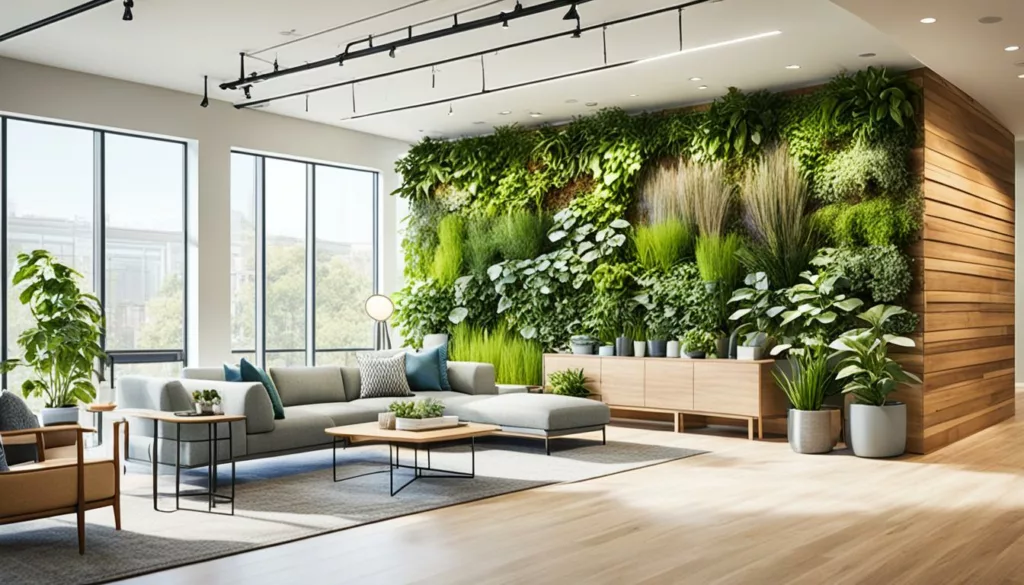
Inclusive Design: Embracing Diversity
In today’s world, making things that everyone can use is key. Inclusive design makes sure spaces, products, and experiences work for all kinds of people. It’s about making things that are easy to use for everyone, no matter their abilities or backgrounds.
Using inclusive design makes your work more welcoming and easy to get into. By thinking about what different people need, you make sure everyone can enjoy and do well with what you create.
Designing for Accessibility
Accessibility is at the core of inclusive design. It means adding features that help people with different abilities. Things like easy navigation and other ways to interact make sure more people can use your work.
- Optimize for screen readers and assistive technologies
- Provide clear and simple instructions for use
- Ensure color contrast and legibility for visual accessibility
- Incorporate keyboard-friendly interactions and navigation
Catering to Diverse User Needs
Inclusive design is more than just making things easy to use. It’s about really getting to know what your users need. By thinking about things like age, culture, language, and abilities, you can make things that really help and empower everyone.
- Conduct user research to understand your audience’s diverse needs
- Collaborate with individuals from different backgrounds and abilities
- Offer customization options to support personalized experiences
- Celebrate diversity and foster a sense of belonging
“Inclusive design is not just about accessibility – it’s about creating experiences that are welcoming and empowering for everyone.”
Embracing inclusive design is a big change in how we make things. By focusing on making things easy for everyone, you open up new chances for a more fair and welcoming future.
Motion Design: Bringing Life to Your Space
Motion design is a trend that adds life to both physical and digital spaces. It uses animations and dynamic elements to make experiences more engaging and immersive. This can grab the attention of your audience in a big way.
Subtle Animations for Engaging Experiences
Learning about motion design is key to making your designs look better and work better. It includes everything from smooth transitions to eye-catching animations. Motion design can make your website, app, or physical space stand out. It turns normal experiences into ones that really grab your audience.
“Motion design has the power to transform static designs into living, breathing entities that spark wonder and delight.”
Knowing how to use motion design lets you add dynamic parts to your work. This helps guide the viewer’s attention and makes things feel smooth. You can use things like hover effects and scrolling animations to make your designs pop.
- Explore the use of micro-interactions to enhance user engagement.
- Incorporate smooth transitions between different design elements.
- Experiment with parallax scrolling to create depth and movement.
- Leverage subtle animations to guide the viewer’s eye and create a cohesive flow.
Using motion design can make your designs look and work better. It makes your creations more dynamic and engaging. Let your designs come alive with the power of motion.
Design Trends: The Driving Force
The world of design is always changing, thanks to new tech and cultural shifts. These changes shape design trends. It’s key for design lovers to keep up with these changes.
Design trends capture the interest of designers, business owners, and buyers. They go beyond just looking good. They show the innovation in the industry and what people want. Knowing what drives these trends helps you succeed in design.
“Design trends are not just about aesthetics; they reflect the pulse of the industry and the changing needs of the people we design for.”
Minimalist design and sustainable practices are just a couple of the trends shaping the industry. They come from a mix of technology, culture, and what people like. Keeping an eye on these trends lets you make designs that look great and connect with people.
Adapting to the changing design trends is crucial for creativity. By knowing what’s new and what people want, you can lead in the design world. This makes you a pioneer in design.
Blending Styles for a Unique Look
Make your living space stand out by mixing different design styles and elements. Learn how to combine various aesthetics, materials, and patterns. This way, you can make a space that shows off your unique taste.
To get a unique design, balance different textures, colors, and furniture. This makes every room in your home more interesting to look at and touch.
Mixing and Matching Design Elements
Feel free to mix design elements from different styles, like:
- Pairing modern, minimalist furnishings with rustic, natural accents
- Blending sleek, industrial-inspired lighting with plush, bohemian textiles
- Incorporating traditional, ornate pieces alongside clean-lined, contemporary decor
Use a common thread, pay attention to size and proportion, and mix materials and textures. This helps create a look that’s both beautiful and cohesive.
“Blending styles is an art form that allows you to create a truly unique and personalized living space.”
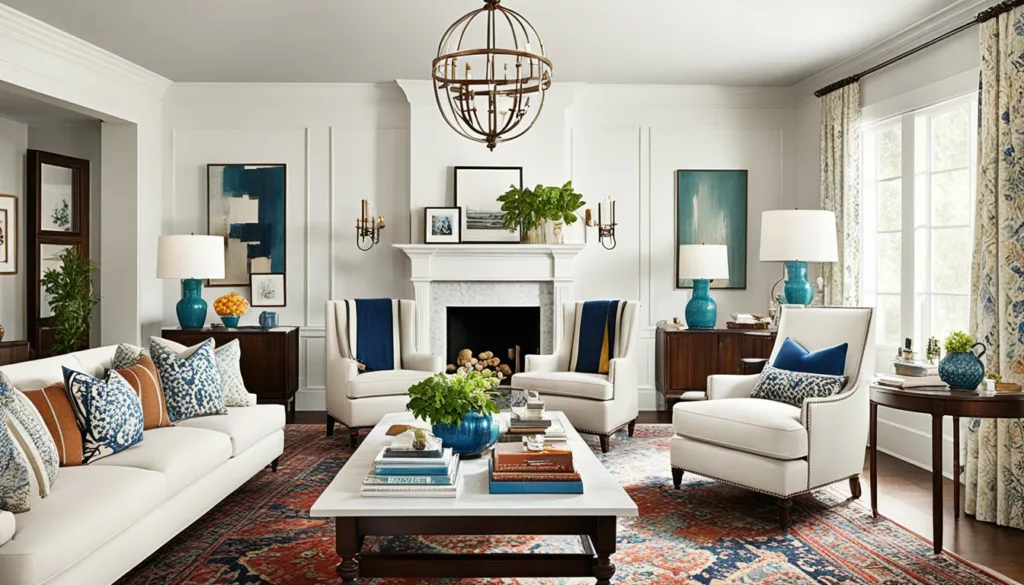
Remember, the secret to mixing design elements well is to try new things, be creative, and enjoy the process. By combining different styles, you open up a world of design options. This way, you can make a unique design that shows off your personal style.
Personalization: Making It Your Own
Design trends are always changing, but personalization is a big hit. It lets you make your living space truly show off your style and personality. Whether you want a cozy spot or something bold, you can do it with personalization.
It’s about adding special touches that match your tastes and hobbies. You can choose custom furniture, art, and design elements. Mixing these with a unified design makes your space look great and feel welcoming.
Picture a living room with a unique, handmade coffee table. Or a bedroom with a mural of your favorite place. These touches add beauty and make your space feel real and meaningful.
Personalization isn’t just about looks. It can also improve how your home works. Custom storage, secret spots, or unique lighting can fit right in while meeting your needs.
“Personalization is the key to creating a space that truly reflects your unique identity and makes you feel at home.”
Looking to add some fun to your living room or make your office a place of creativity? Personalization is the way to go. It lets you express your style everywhere in your home.
Conclusion
The design trends we’ve looked at offer a lot of inspiration for your space. You can choose from minimalist looks, bold colors, or designs that focus on the user. These options can make your home or office look better.
Design is always changing, and using these new ideas can make your space unique. It can show off your style and vision.
To make your design dreams come true, talk to the experts at Prestige (541-852-9184) for kitchen and bathroom remodel ideas. Their skilled designers can mix old and new styles. This ensures your space shows off your personal taste.
Success in design means finding the right mix of looks, function, and personal touch. By using the latest trends and working with experts, you can make a space that’s both beautiful and practical. So, let your creativity flow and get ready to turn your home or office into a masterpiece.
FAQ
What are the hottest design trends in the United States?
The top design trends in the U.S. include minimalism, bold colors, new typography, and user-focused design. Also, mobile-first design, sustainable practices, inclusive design, and motion design are big. These trends are changing how we design spaces, making them look great and work well.
How can I incorporate minimalist design in my space?
For minimalist design, focus on simplicity and usefulness. Clean up your space to make it calm and clear. Use simple lines and open areas to make a room look good and work well.
What are the benefits of using captivating color palettes?
Using bright colors can change the feel of a space. Earthy tones and soft colors make a space calm and peaceful. Learn how to use these colors to make a space welcoming and harmonious.
How can typography enhance the design of my space?
The right fonts can make a big statement in your design. Choose fonts that look good and match the mood you want. See how typography affects branding, signs, and digital designs to make your design strong and unified.
What is user-centric design, and how can it improve my space?
User-centric design puts the user first. It makes interacting with your space easy and enjoyable. Create spaces and products that are easy to use, look good, and meet your audience’s needs.
How can I optimize my designs for mobile devices?
With more people using mobile devices, designing for mobile first is key. Learn how to make your designs work well on all devices. Make sure your designs are easy to use and look good on mobile to keep up with digital trends.
What are the latest trends in sustainable design?
Sustainable design aims to lessen environmental harm. Use eco-friendly materials and green practices. Add sustainable elements to your designs for a look that’s good for the planet and pleasing to the eye.
How can I create a more inclusive design?
Inclusive design means making spaces for everyone. Learn how to make your designs accessible to all. Use design principles that welcome people with different abilities and backgrounds.
How can motion design enhance my space?
Motion design adds life to your space, both in real life and online. Use animations and dynamic elements for a fun and engaging experience. Apply motion design to grab attention, improve interaction, and make your designs stand out.
What factors influence design trends?
Many things shape design trends, like new tech, cultural shifts, and changing tastes. Understand what drives design trends to stay ahead. Use this knowledge to adapt and lead in the design world.
How can I blend different design styles to create a unique look?
Mixing design styles lets you create a space that’s all your own. Learn to combine different aesthetics and elements for a unique look. Use a mix of styles to make a space that’s both cohesive and eye-catching.
How can I personalize my space to make it truly my own?
Making your space personal is a big trend. Add custom pieces, art, or special design features to make it yours. Balance personal touches with overall design to create a space that reflects your style and is pleasing to look at.

